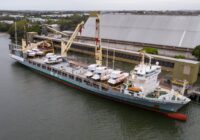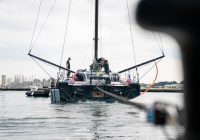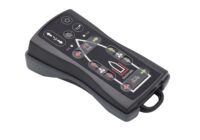After picking up 2-1-2 results at the last three events, there’s no denying that NorthStar Canada will arrive in New York as one of the fleet’s in form teams. Ahead of this season’s sixth event, team CEO Phil Kennard reflects on the team’s 2025 Season journey so far, from replacing former driver Phil Robertson and ‘controversially’ changing the team name, to initial performance expectations – and disappointments – before the team’s string of podium results.
Members of the NorthStar Canada team have been candid about its precarious position last season. It was no secret the Canadian team was ‘on the chopping block’, according to flight controller Billy Gooderham, if it didn’t find new ownership. Luckily, the team caught the eye of Canadian biotech entrepreneur Dr Greg Bailey, who acquired the team ahead of the 2025 Season. Alongside the acquisition, Bailey appointed Phil Kennard CEO of the team. Kennard is no stranger to high end sports, previously holding commercial roles in Formula 1, the PGA Tour and America’s Cup.
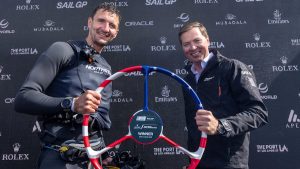
Once in post, Kennard began ticking off his immediate priorities. The first was securing the team’s current personnel – both the ‘sailing talent’ and ‘behind the scenes roles’. “Effectively we were buying the license to operate the Canadian team,” he says, “but none of the members of staff on the team were contracted.” In fact, those contracts had expired months previously. “The number one concern was having the sailors and support staff on the team.” This was even more important in the changing landscape of the SailGP fleet and addition of new teams Mubadala Brazil and Red Bull Italy. Both teams were being ‘aggressive’, Kennard says, in their acquisition strategy of experienced athletes. “They wanted experience and we found ourselves in a bit of a battle to get the talent we wanted,” he explains. “It was a jigsaw puzzle to ensure we hit the nationality rule and could get the people we felt were important to the performance of the team.”
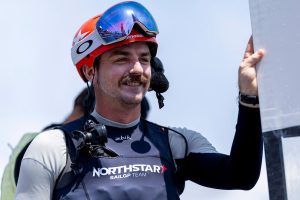
Securing the ‘Canadian base’ and meeting the nationality requirements was the first priority, and Kennard worked quickly to tie down flight controller Billy Gooderham, grinder Tom Ramshaw and strategist Annie Haeger. From there, the focus shifted onto securing wing trimmer Paul Campbell-James, who was receiving offers from multiple teams. Kennard describes Campbell-James as ‘one of the unsung heroes of SailGP’. Locking him in was just as important as securing Gooderham – Kennard places equal importance on possessing an experienced wing trimmer and flight controller.
“If you don’t have that, you’re a bit screwed and you’re also not going to be able to get the potential driving talent you want,” he says. Once those positions were ‘nailed down’, Kennard and Bailey’s conversations shifted to ‘the best person to lead the team’.
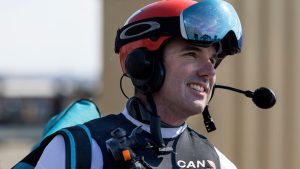
The pair ‘weren’t necessarily looking to replace’ former driver Phil Robertson, Kennard says, describing him as ‘one of the most experienced F50 drivers on the planet’. But the pair nevertheless had ‘discussions with a few potential drivers’ ahead of confirming the crew line-up, including current Emirates GBR driver Dylan Fletcher.
Eventually, a rumor reached them that then-Emirates GBR driver Giles Scott ‘could be available’. Not only was Scott interested, but he possessed a Canadian passport. From that moment, Bailey and Kennard were ‘actively’ pursuing Scott which, Kennard says, was at odds with the press reports at the time. These focused only on Scott’s fallout with Emirates GBR CEO Ben Ainslie over the 37th America’s Cup.
“It was all about Giles getting sacked from the America’s Cup and looking for something else, but from our point of view, we wanted him and actively went out looking to hire him,” Kennard explains.
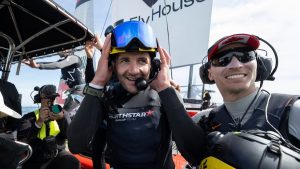
Scott’s appeal, aside from his Canadian passport, was his impressive SailGP track record and his sheer ‘potential for performance’. Kennard points to his entry into SailGP midway through Season 4. “He did seven events with Emirates GBR, podiumed half of them and won one,” Kennard says. “Coming in and being able to do that straight off was a big indicator to me that he’s a star of the future.”
When it came to the possibility of replacing Robertson – a SailGP veteran with experience leading three fledgling teams – Kennard and Bailey ‘weighed up a lot of different options’. Even now Kennard ‘takes nothing away from Phil’ and is quick to highlight his ‘fantastic track record’. “For me, it was all about potential and I think Giles had shown a steeper learning curve that hadn’t finished,” he says. It was also an opportunity, he adds, for him and Bailey to ‘stamp [their] authority on the team’. “It gave us a chance to say that we’re going to change how we do things, from commercial operations and communications, to on the water as well.’
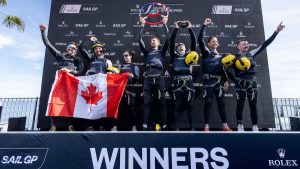
Fans might think there is no bigger team change that can be made than swapping out the driver. But Kennard and Bailey weren’t done. As well as replacing Robertson, they decided to completely rename the team, casting out ‘Canada SailGP Team’ for ‘NorthStar SailGP Team’. The decision, Kennard admits, was ‘one of the most potentially controversial things we did at the beginning of the season’ and initially prompted ‘horrendous backlash’ from the team fanbase. But it was a change prompted by a desire to give the team its ‘own brand’ and ‘build it as a sporting entity.’ Luckily, NorthStar’s fanbase has softened its opinion and even embraces the name now – Kennard is relieved. “I’d like the name of the team to grow over the new few years and become synonymous with a Canadian team representing the country on the world stage.” The name change was also crucial, he says, to opening up commercial opportunities, enabling the team to ‘attract international businesses alongside Canadian ones.’ Kennard points to the team’s recent partnership with FlyHouse – an American company based in Arizona. “I think if we had remained as the Canada SailGP Team we wouldn’t have been able to secure opportunities like that.”
With the revamped crew line up and brand new name, the team prepared to begin its 2025 Season racing campaign. Dubai beckoned, but offered no firm expectations.
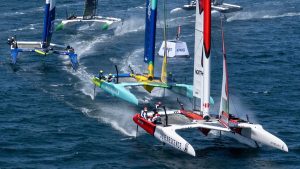
“I had absolutely no idea what would happen,” Kennard says, adding that the team’s sixth place finish ‘ran to form’. Despite this, Dubai was ultimately a disappointing event. At the end of racing on Saturday, the team was tied on points for third. “I was thinking that we might get into the Final,” Kennard says. But a ‘disappointing Sunday’ robbed them of that chance. Despite this, the extra training days before and after the event allowed crucial ‘team bonding’, which set the team up to overcome adversity in Auckland. The team had a disappointing performance on Saturday, which was followed by the injury of flight controller Billy Gooderham on Sunday, which ruled them out of racing. The team finished the event in 10th overall. After Auckland, the team underwent a ‘rebuild’. Its on-water performance had been disappointing – ‘the team just weren’t on the same level of competitiveness as the Australians, Kiwis, Brits, Spanish – and even other teams like the Danish and Swiss’, Kennard says. “We were not getting to where we wanted to be and I was sitting in the team base on Saturday evening thinking something’s just not working’.
Ahead of the next event in Sydney, the team did ‘a lot of soul searching’ and brought in a performance analyst to undertake its own ‘data development work’ based on the ‘Formula 1 style of data analysis’. Coach Joe Glanfield was also crucial in ‘bringing the team together and identifying areas that needed improvement’. Sydney dawned and suddenly the team ‘was just on fire’, Kennard says, soaring into the Final and coming within touching distance of winning the event. But missing the win only added to the team’s motivation. Scott’s crew to come back firing in Los Angeles, securing its first event win of the season before following up the result with a second place finish in San Francisco.
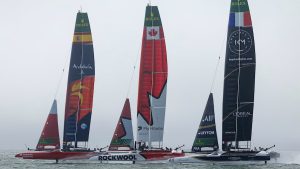
Despite the string of podium results, Kennard is honest that ‘it could all stop or we could struggle in the future’. But he takes confidence from the team’s ability to execute high level performances in the drastically different conditions of the three different venues. We were on the pace in Sydney – in Los Angeles, we had light winds, flat water and four crew on the boat, in San Francisco it was very different again, quite windy and choppy,” he says – ‘we were able to get performance from the boat in three very different set of conditions.’ As a result, heading into New York, Kennard says there’s no concern from his side ‘about the conditions’. “It’s just about racing hard and making sure we get off the start line.” There has however been the disruption of Rio’s cancelation to allow time for essential F50 repairs, resulting in a 10 week gap between San Francisco and New York. “It’s challenging to keep everyone motivated and engaged with an enforced lay off,” Kennard admits, but says the message now is that ‘holidays are over, it’s time to reengage and make sure we’re ready to go’. In the enforced break, the team hasn’t been idle. There’ve been fitness programs, data analytic research and on the water training as the crew fights to ‘stay up to speed’ for the event on June 7 & 8.
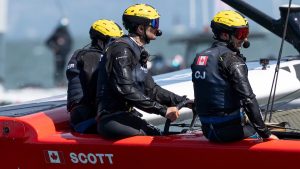
On his way to New York, Kennard will visit Halifax in anticipation of the team’s return to home waters in June 2026. Seeing the ‘fan reception’ to that event last season was, Kennard says, ‘one of Greg’s driving factors in buying the team’. “To see the depth of passion and feeling that Canadian fans have for SailGP and this team in particular was really exciting,” he says. “We’re looking forward to getting back in front of Canadian fans.”





